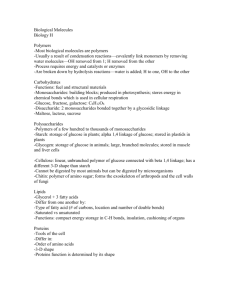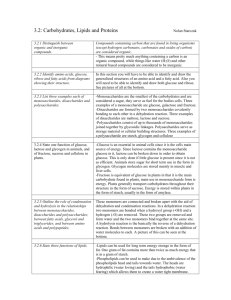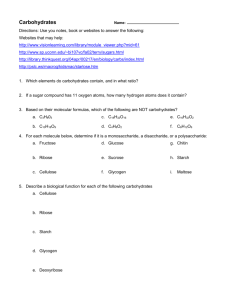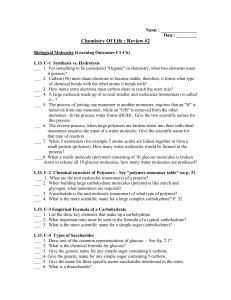Biological Molecules
advertisement
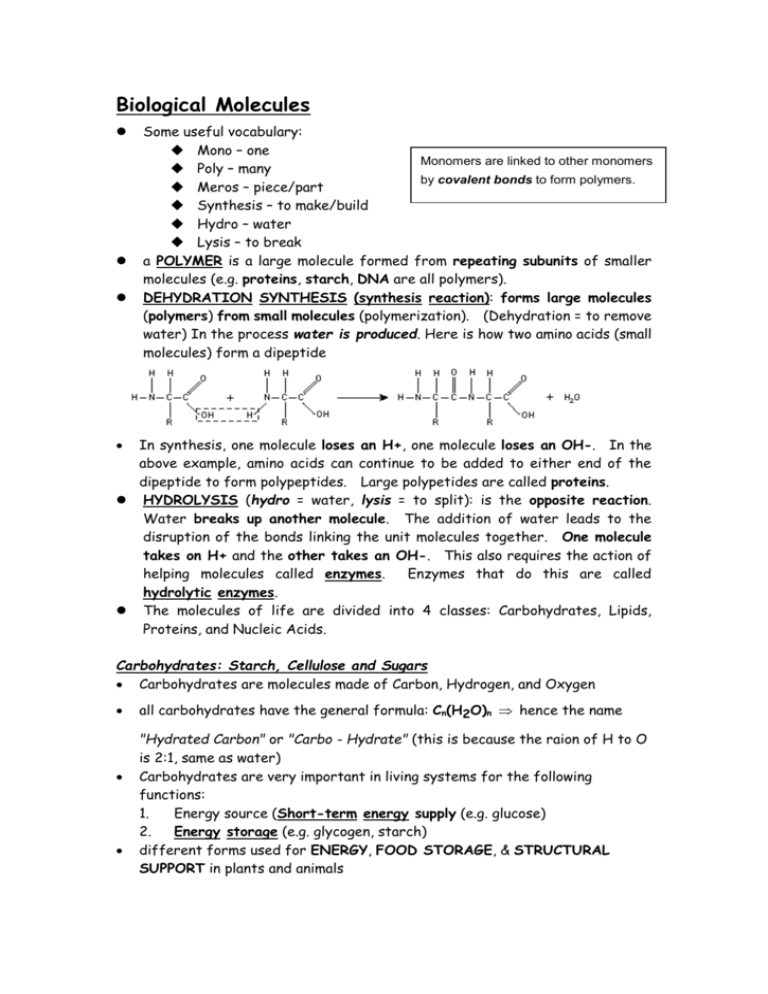
Biological Molecules Some useful vocabulary: Mono – one Monomers are linked to other monomers Poly – many by covalent bonds to form polymers. Meros – piece/part Synthesis – to make/build Hydro – water Lysis – to break a POLYMER is a large molecule formed from repeating subunits of smaller molecules (e.g. proteins, starch, DNA are all polymers). DEHYDRATION SYNTHESIS (synthesis reaction): forms large molecules (polymers) from small molecules (polymerization). (Dehydration = to remove water) In the process water is produced. Here is how two amino acids (small molecules) form a dipeptide In synthesis, one molecule loses an H+, one molecule loses an OH-. In the above example, amino acids can continue to be added to either end of the dipeptide to form polypeptides. Large polypetides are called proteins. HYDROLYSIS (hydro = water, lysis = to split): is the opposite reaction. Water breaks up another molecule. The addition of water leads to the disruption of the bonds linking the unit molecules together. One molecule takes on H+ and the other takes an OH-. This also requires the action of helping molecules called enzymes. Enzymes that do this are called hydrolytic enzymes. The molecules of life are divided into 4 classes: Carbohydrates, Lipids, Proteins, and Nucleic Acids. Carbohydrates: Starch, Cellulose and Sugars Carbohydrates are molecules made of Carbon, Hydrogen, and Oxygen all carbohydrates have the general formula: Cn(H2O)n hence the name "Hydrated Carbon" or "Carbo - Hydrate" (this is because the raion of H to O is 2:1, same as water) Carbohydrates are very important in living systems for the following functions: 1. Energy source (Short-term energy supply (e.g. glucose) 2. Energy storage (e.g. glycogen, starch) different forms used for ENERGY, FOOD STORAGE, & STRUCTURAL SUPPORT in plants and animals H O CH2 H OH if the number of carbon atoms is low, the carbohydrate is a simple sugar Monomer (monosaccharide) simplest sugars (generally referred to as glucose) serve as building blocks for more complex sugars Examples: "hexose" = 6-C sugar, 5-C sugars = "pentose" sugars) Glucose, a hexose, is blood sugar and is used as an immediate source of energy (fructose and galactose are other common hexoses and have the same molecular structure C6H12O6, but different ring structures and different chemical properties) O O H OH OH H H OH H Glucose is a monomer for larger carbs. The body uses Condensation synthesis to join monomers together to build larger molecules (water has been removed as monomers are joined together Glucose is formed in green plants by photosynthesis 6CO2 + 6H2O + Light energy C6H12O6 + 6O2 DISACCHARIDES: formed from dehydration synthesis, synthesis reaction, between two monosaccharides O Mono + Mono Di + Water O i.e. glucose + glucose = maltose + water glucose + fructose = sucrose + water glucose + galactose = lactose + water O These reactions are REVERSIBLE (hydrolysis) Monosaccharides and disaccharides are all water soluble POLYSACCHARIDES: a carbohydrate that contains a large number of monosaccharide molecules. Starch and Glycogen are polysaccharides, and are polymers of glucose for plants (starch) and animals (glycogen). Three main important types in living systems. All are made of repeating glucose subunits: 1) STARCH - the storage form of glucose in plants. Made of fairly straight chains of glucose, with few side branches off the main chain. The structure is BRANCHED. 2) GLYCOGEN - the storage form of glucose in animals (stored in the liver and muscle cells). Many side chains of glucose. In animals, the liver converts glucose to glycogen for storage. In between meals, liver releases glucose into blood so blood [glucose] remains at 0.1%. The structure is HIGHLY BRANCHED 3) CELLULOSE – most relevant on earth, primary structural component of plant cell walls. Linkage of glucose subunits different than in starch or glycogen. The structure is UNBRANCHED Human digestive system can’t digest cellulose, so it passes through the intestines undigested. Other names for the cellulose in plant foods are "fiber" or "roughage." dietary fiber is important to health and for the prevention of such things as colon cancer.


